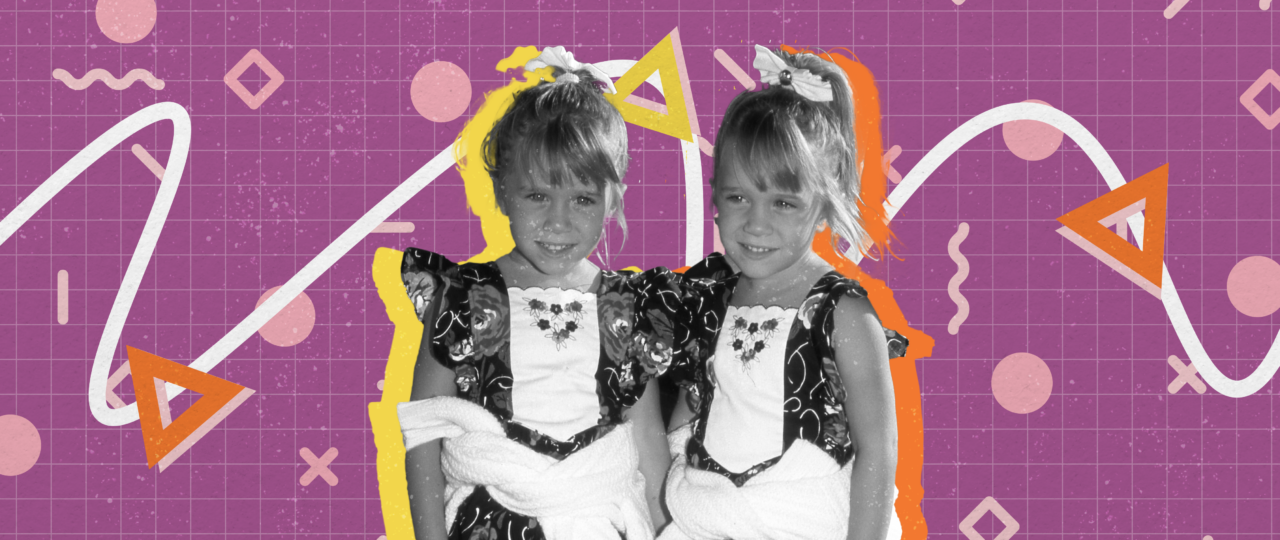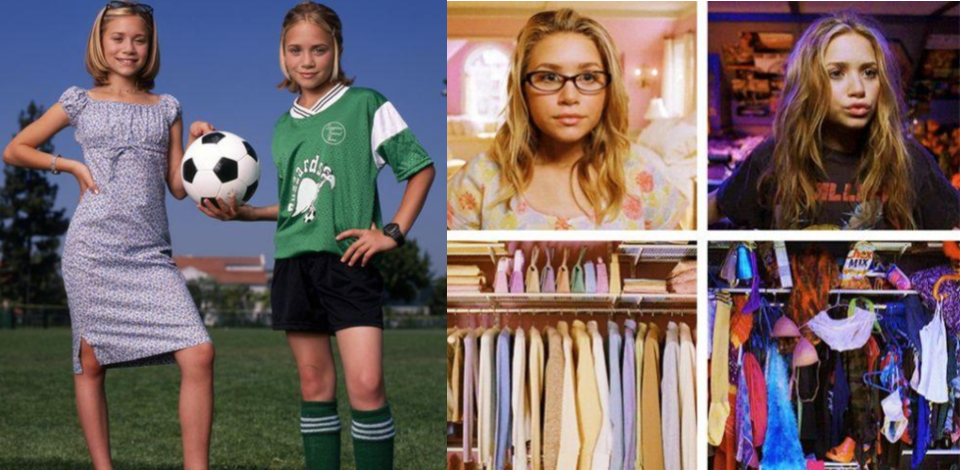The year is 2000. The final frame of the television movie Switching Goals, which follows 13-year-old twin sisters who fool everyone by switching places on their opposing soccer teams, flashes across the TV.
As the credits roll, my seven-year-old mind races. I have never played soccer in my life, but I think it might be my passion. I stand up to go ask my parents if I can sign up for a soccer team.
This was the power of Mary-Kate and Ashley Olsen.
“For many young girls, [Mary-Kate and Ashley] were their first celebrity idols — fans felt a powerful connection as they watched the twins grow up in the public eye,” says a 2018 feature in The Washington Post. “As quite a few millennial women can tell you, Olsen nostalgia has a powerful hold.”
As one of those millennial women indoctrinated into the Olsen empire, I can empathize. It’s not just a powerful hold, it’s a chokehold — one that has had me in its grips since I was five years old, and one that will never fully go away.
But despite how ubiquitous their presence in the fabric of millennial pop culture may be, it didn’t come into existence overnight. The Olsen twins’ rise to fame was a phenomenon I’m not sure we may ever witness again — and its cultural impact still stands today.
The beginnings
Most people know that the Olsen twins made their debut on Full House, where they were cast to play Michelle Tanner at just six months old. Michelle, and thus the twins, quickly became the deeply adored darlings of America, catapulting them into a career that would last nearly two decades.
In 1993, at age six, they (their parents/management) founded Dualstar, a production company to develop and produce film and TV projects. During their last couple of years filming Full House, Mary-Kate and Ashley started appearing in their first direct-to-video and/or TV movies featuring theatrical versions of themselves: To Grandmother’s House We Go, Double, Double, Toil and Trouble, and How the West Was Fun.
Around this time, a handful of other notable entries into the Mary-Kate and Ashley sacred timeline come into existence: 1995’s It Takes Two (their feature film debut), The Adventures of Mary-Kate and Ashley, a direct-to-video series in which they are acclaimed child detectives inexplicably hired by grown adults to solve mysteries, and “You’re Invited to Mary-Kate and Ashley’s…,” another direct-to-video series in which they host the same sleepover over and over again, except with different themes like “ballet” and “Hawaiian luau.”
Did it matter that it made no logical sense why actual astronaut and fourth person to walk on the moon Alan Beam would recruit the Olsen and Olsen Mystery Agency to investigate a problem with a NASA Space Shuttle? No! Were Dualstar execs worried about inviting overexposure by producing a chapter book version of every single VHS? Absolutely not. None of that mattered, because we ate it up. We were torn between wanting to be them and wanting to be their best friends. No amount of Mary-Kate and Ashley could be too much.
The glory years
The success of these direct-to-video series led directly to what I can only describe as the movie boom. From 1998 to 2003, the twins cranked out 1–2 direct-to-video movies a year, starring in each as a set of twin sisters lightly adapted from themselves and with certified “cool girl” names like Riley and Chloe and Sam. They became bona fide globetrotters, centering each movie around visiting a new fabulous city and then sprinkling on a loose plot line and a set of opposing interests for the twins as an afterthought.
You can view a full list of the movies here, but some of the most absurd entries in the movie boom that are worth highlighting include:
- Billboard Dad (the one where they — as the title suggests — advertise their widowed father’s singledom on a billboard in Los Angeles)
- Passport to Paris (the one where they get sent on a trip to Paris as punishment for liking boys)
- Our Lips Are Sealed (the one where they very casually witness a diamond heist and are then very casually put in the Witness Protection Program in Sydney, Australia, which is a very normal plot for a children’s movie)
- Getting There (the one where they get their driver’s licenses and immediately go on an obstacle-ridden cross-country road trip to the 2002 Winter Olympics in Salt Lake City)
- The Challenge (the one where they compete on a Survivor-like show in Mexico, but to win college scholarships, naturally)
- New York Minute (their last movie as a duo, and the one where they have a chaotic day in New York filled with the kind of gags that only someone who has never spent considerable time in New York could write)
These movies are the core of the Mary-Kate and Ashley canon. They are the movies that made me fight with my friends on the playground about who got to be Mary-Kate and who got to be Ashley during recess. They are the movies that made us devastated that we did not have twin sisters and made us resent the twins in our lives because of how much we envied them.
They are also the movies that made way for a never-ending conveyor belt of Mary-Kate and Ashley-branded products that filled up the birthday and holiday wish lists of tweens across the nation — and the pockets of everyone at Dualstar.
The merchandise
By the beginning of the movie boom, Dualstar knew that anything involving Mary-Kate and Ashley equaled money. You could wear Mary-Kate and Ashley clothing and makeup. You could play Mary-Kate and Ashley video games on your Playstation and CDs of their greatest hits like “Brother for Sale, 50 Cents” on your Mary-Kate and Ashley boombox.
One particular piece of merchandise that will be burned into my brain forever is a pair of Mary-Kate and Ashley Barbie-like dolls (each sold separately!) that were advertised in an iconic TV commercial.
“Mary-Kate and Ashley are really cool. It would be so much fun to hang out with them!” laments a young girl, who could have easily been me. “We can!” squeals her friend.
And if you’re a young fan, isn’t that the whole point? Using dolls to fulfill your dreams of having a super sleepover party with your best friends, Mary-Kate and Ashley?
Unlike other massive entities that endlessly merchandise the faces of their franchises, these products rarely focused on the characters the twins played — it was all just Mary-Kate and Ashley. When a new Marvel movie comes out, merchandise is everywhere, but the faces on the products aren’t Brie Larson and Mark Ruffalo, they’re Captain Marvel and the Hulk.
It’s tough to think of a modern equivalent to this particular type of merchandise empire, and I think that’s because there really isn’t one. Sure, influencers will rise to fame on Instagram or TikTok and launch a line of beauty products or coffee or Dunkin Donuts onesies, but nothing compares to the absolute avalanche of cross-medium, cross-industry products that added to the twins’ cultural dominance.
The messages
Somewhere in the midst of re-analyzing all of this material as an adult, I had one of those moments of clarity that resulted in an epiphany. That epiphany is this hot take: I think the Mary-Kate and Ashley canon is responsible for a great deal of internalized misogyny in millennial (and early Gen Z) women.
During the Mary-Kate and Ashley movie boom, another crucial component of the magic formula was the finely curated set of characteristics that defined each twin. They look alike, but they couldn’t be more different! was the mantra that each movie forced down your throat.
Mary-Kate likes horses and blue, Ashley likes ballet and pink. Mary-Kate is a daring tomboy who likes sports, Ashley is an uptight goody two-shoes who likes homework. Every movie forced this dichotomy of their characters, and in doing so, coded the sporty twin (usually Mary-Kate) as the cool tomboy girl, and the other (usually Ashley) as the boring girly girl. We learned to idolize the Mary-Kate prototype for being “one of the boys” and resent the Ashley iteration for representing stereotypically feminine qualities and interests.
Image credit: Dualstar Entertainment
Considering that we consumed this material while also growing up in a world that liked to shame femininity, it’s no wonder that a generation of young women came of age thinking they needed to put other girls down in order to make themselves seem more desirable to men. (See “I’m not like other girls” culture.)
On a similar note, you’ve probably heard of the “dead mother” trend among classic Disney movies, which is exactly what it sounds like — a trend in which the mothers of the main characters (think: Ariel, Jasmine) are often dead.
Well, in Mary-Kate and Ashley world, history repeats itself. Comedian, writer, and now Olsen twin scholar Ayo Edebiri did the lord’s work by compiling data on the twins’ characters’ parental situation over the course of the movie universe:
Credit: Ayo Edebiri on Twitter
Please note the action in the “widower father” column. In real life, the twins’ parents divorced toward the beginning of their post-Full House career, so one could understand why separated or divorced parents would be a prevalent theme in their material.
But why did the mother have to be dead so often?
If the prevalence of the dead mother trope wasn’t evident enough in list form, here’s another way of looking at it.
Credit: Ayo Edebiri on Twitter
Is this use of widowed fathers as a plot device a desperate attempt to give depth to lead characters who have zero defining traits other than being twins with opposite interests? Is it a way of garnering sympathy for the fictional father, who must be so in over his head raising two daughters on his own?
Regardless of the intention, it projects a questionable message about the role of women in the lives of young girls.
Where are they now?
These days, the Olsen twins live their lives primarily out of the spotlight, which has been the case since they turned 18. They are focused on their well-respected fashion brand, The Row, and they rarely give interviews or make public appearances, which only increases the aura of mystique around them.
We grew up with these girls, and then they just disappeared. What they left in their absence was a generation of girls like me with a deep nostalgia for their legacy — not just because they remind us of the simpler days of being kids, but also because we know they were a once-in-a-universe phenomenon.
Mary-Kate and Ashley didn’t need characters. They were just them, and that was enough. The media properties they created and the characters they played were just vessels through which they could further extend the grip they held on us — though at the time, I don’t think either party knew just how long that grip would last.






